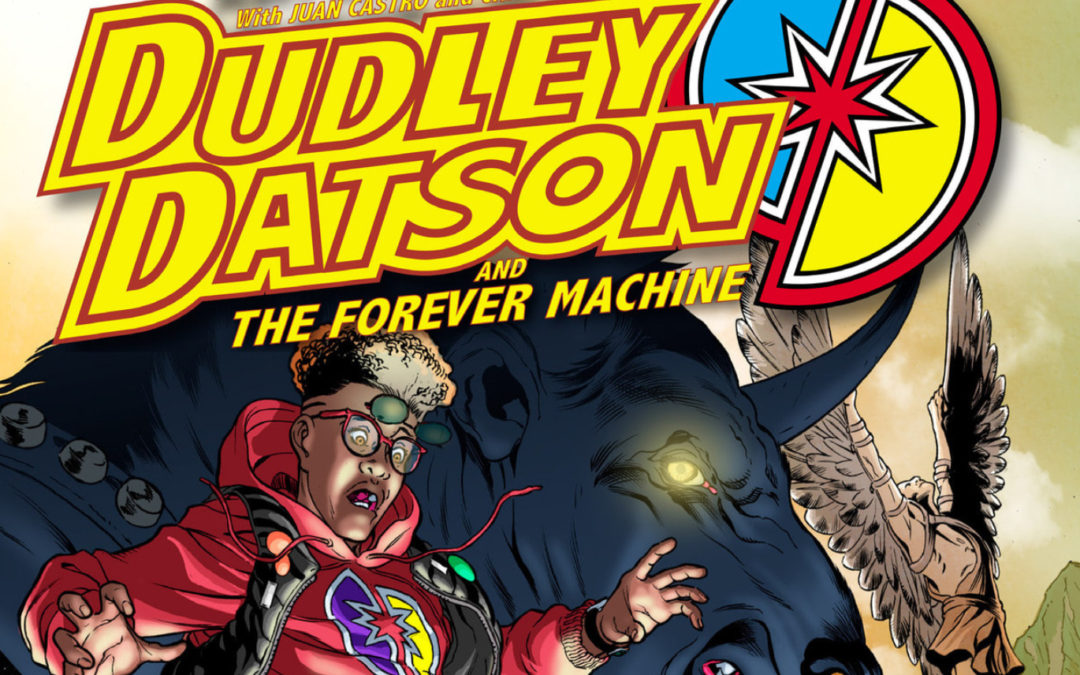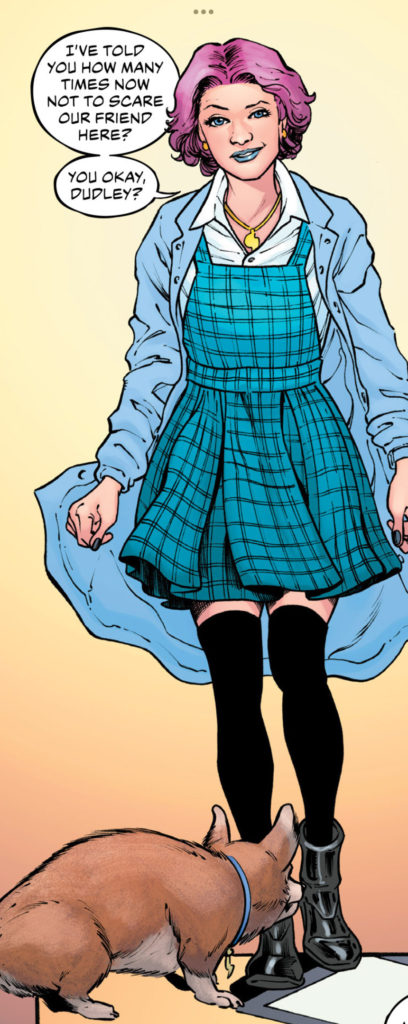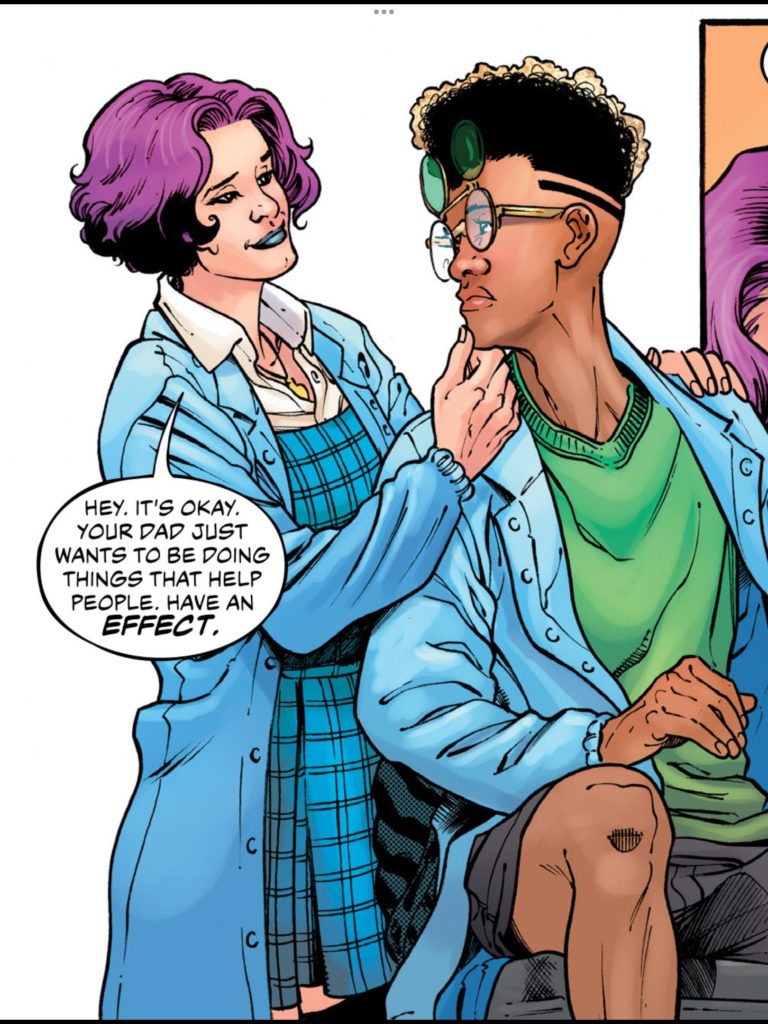Full disclosure – I’m a sucker for young STEM students as heroes of stories. That’s what we have in Dudley Datson and the Forever Machine from Amazon’s Comixology Originals imprint.
Written by Scott Snyder, with terrific art by Jamal Igle, the debut issue sets up the players and the story. It’s a remix of what works – a wily protagonist in Dudley, a menacing, all-powerful enemy with a mysterious backstory, a humorous sidekick, the ill/ailing parent, tech advanced enough to be seen as magic, a guide to the new world (this time, a Corgi), and of course, the call to adventure.
The ending has a cliffhanger, with the promise of more adventure to come, a line that may make you think of the Ninth Doctor, and a bucket of mysteries to be solved. Also, it’s got a solid vibe that’s reminiscent of the Dexter Riley Disney movies, starring Kurt Russell as the Medfield College student whose inventions and intellect got him into bizarre situations.
Nothing entirely new under the sun, but still, it’s a fun story that got me to buy issue #1 and subscribe to the rest. Let’s see where this goes, right? Already admitted – I’m an easy mark for this type of story.
Okay – that said a minute for science and science education. In talking about this, I’m fully aware that showing science education, classrooms, classes, and STEM educators in comics has a long and interesting history. Somehow Peter Parker was able to get all the chemicals to make a revolutionary type of adhesive from what was in the chem supply room after all. That set the bar pretty high. Fictionally high, but still high.
So…
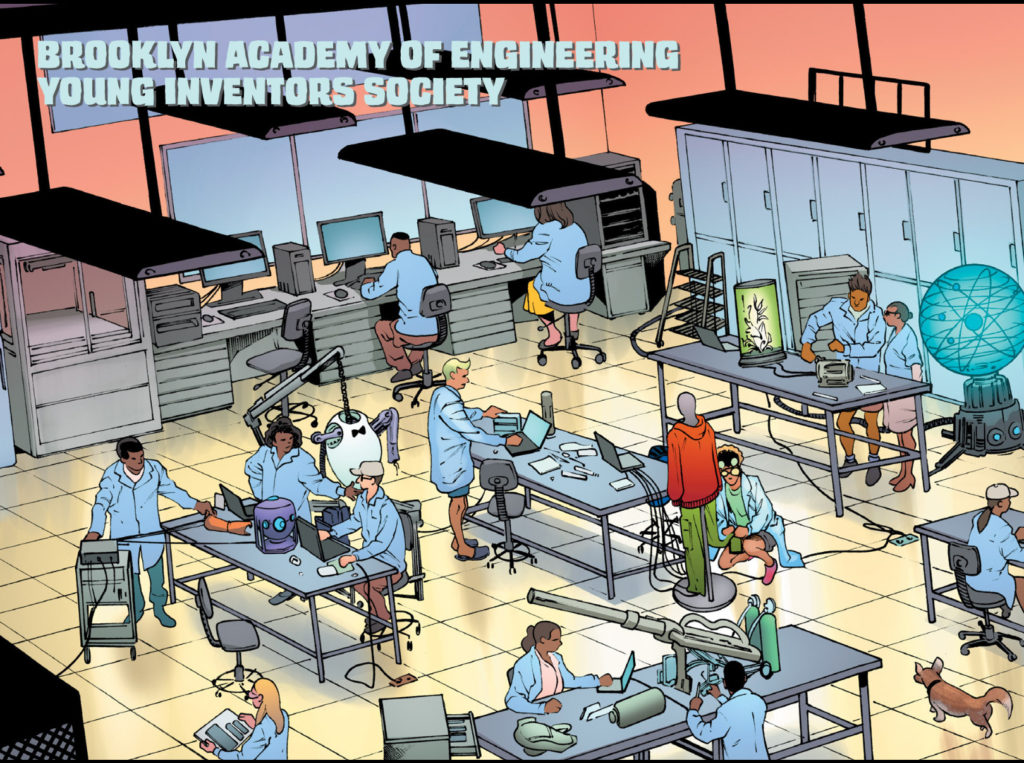
The Brooklyn Academy of Engineering Young Inventors Society has mad cash. Art by Jamal Igle, Juan Castro, and Chris Sotomayor Image: Best Jackett Press
THE STEM ED PART
Dudley is a student at the Brooklyn Academy of Engineering’s Young Inventors Society. These “science Hogwarts” are pretty much a staple in stories like these, but as a STEM teacher, this place is gigantic. So…much…floor space for a lab. So neat. So clean. So…much. Nothing looks more than maybe four years old. #jealous.
Okay – Dudley’s instructor, Dr. Shae. Fashionable. Hip. Young. And she got into STEM Ed/ Nice! But the troubling thing – when comforting Dudley about his father’s health issues, she is shown to have a hand on his shoulder and the other on his chin. A face touch. Yikes. Yikes. Yikes. Yikes. That’s a huge no-no and annoying that it was even shown.
I can go with the idea that this is just a story and that a fictional school in a fictional world could have a fictional amount of money, allowing every student to create amazing, fictional tech, but that one panel? In an otherwise fun issue, that panel threw me out of the story so hard it knocked my gum out.
But let’s get over to some science.
DUDLEY DATSON: SUPER GENIUS
Can we take a minute to recognize what a freaking genius Dudley is? Of course, I mean his class project – the insanely over-engineered LCD “smart clothes.” It’s a great exercise in just what makes doing this in our world so tough. LCD integrated into clothing is a cool application that’s just starting to crawl into our world, and there’s a lot of work to do. But Dudley has it all figured out.
Let’s break it down.
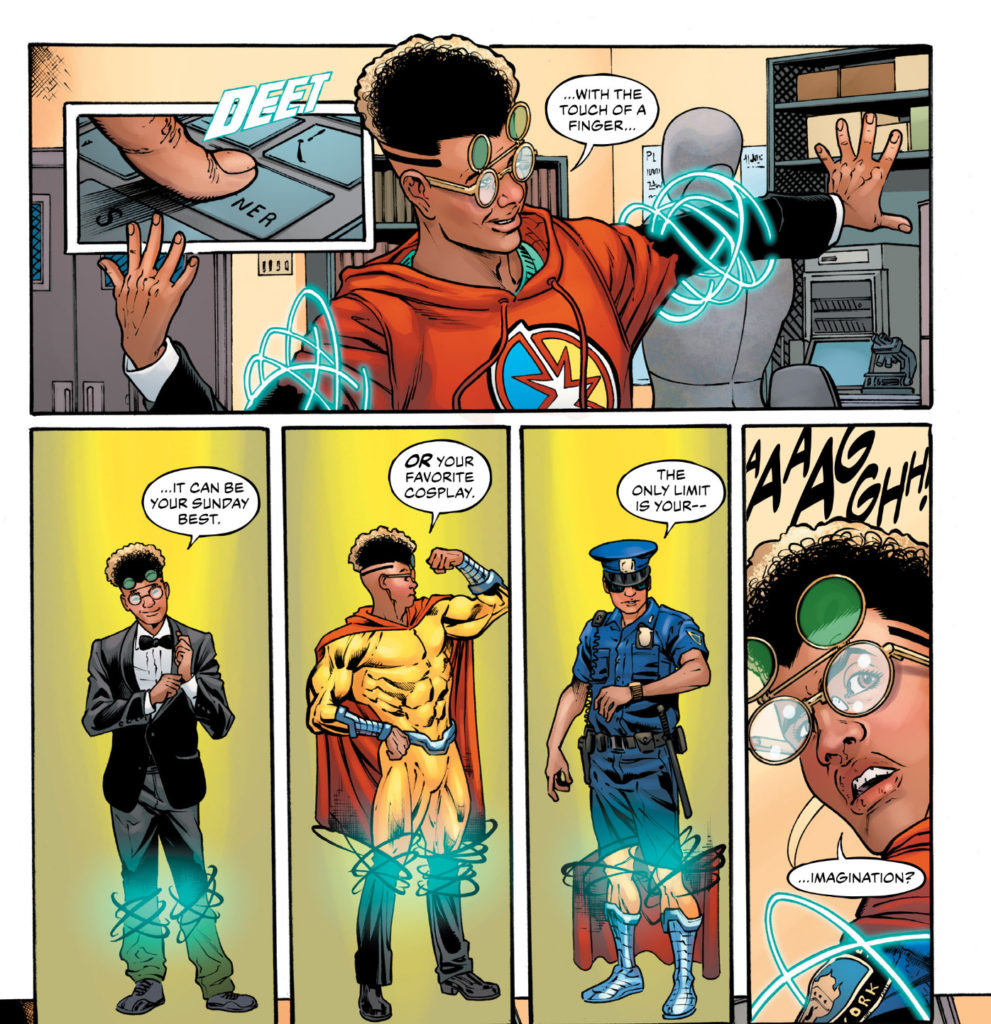
Bending physics as we know it! Art by Jamal Igle, Juan Castro, and Chris Sotomayor Image: Best Jackett Press
Dudley’s “smart clothes” can change their appearance (when they work) by showing an image of different clothes. The fibers making up the clothes contain miniaturized screens showing a piece of an image making up the larger garment image. Dudley’s clothes and processing system (he looks to run his outfit from his phone) would include a database of images and both screens and cameras pointed outward. The cameras would act like microphones on noise-canceling headphones, capturing information about ambient light conditions and adjusting the clothes’ image as needed.
The networking of the fibers would be key — at all times, they’d need to know where they are relative to one another to accurately show overlay, folding, texture, contours, and shading.
Dudley’s “invisibility” that’s shown is just an extension of the above. And allows for a little crossover into (and limitations of) the technology of our world.
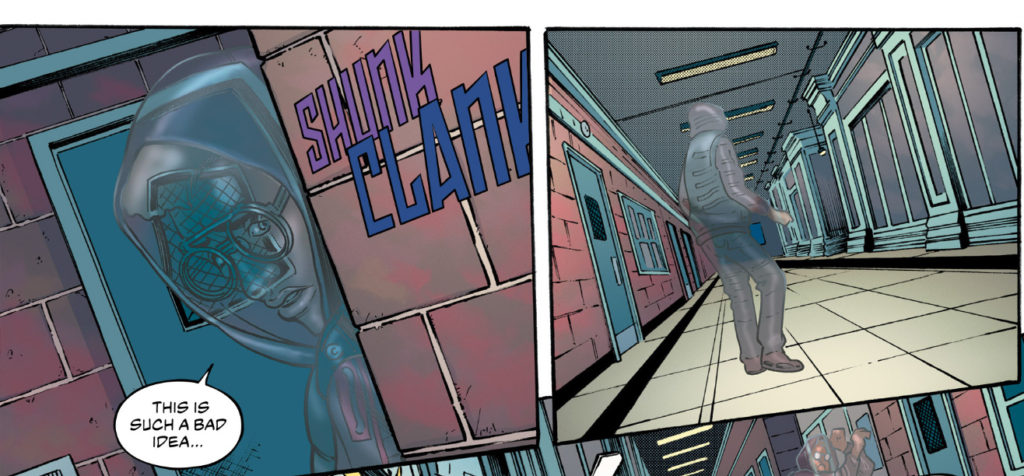
Now you see him; now you don’t. Art by Jamal Igle, Juan Castro, and Chris Sotomayor Image: Best Jackett Press
Remember the outward-facing cameras above? Those would play a major role in invisibility with smart clothes. To be “invisible,” observers need to see what’s behind you as if you’re not there. This is out of the recent Invisible Man movie playbook. The fibers’ cameras on all sides would capture an image of what they see and send the image to exactly the correct spot on the other side of Dudley’s body.
This can work if Dudley is standing still. Once he starts moving, though — anyone looking his way would see a distortion as whatever is processing the images struggles to keep up with capturing, sending, and displaying the images in real-time. Run, and you’re just asking the computer to work harder. Maybe add some artificial intelligence to scan ahead and around and predict the images that will be needed?
The same application of Dudley’s technology to turn invisible would also play a role in changing outfits. Change a bulky winter jacket to a tight bodysuit? Whatever the “real” clothing is — has to look like something else, but that something else has a different volume. Switching images from a bodysuit to a winter jacket means projecting an image where there are no fibers…somehow. Maybe the “real” clothing is a hoodie, as shown in the comic? Change that to a t-shirt and jeans, and you’ve got the opposite problem — the fibers now have to show no clothing where there is clothing.
Finally, this was my favorite and demonstrates the overengineering of Dudley’s smart clothes — the opening pages of the issue. Due to an accident with the control device, the smart clothes go “clear,” resulting in Dudley standing in front of a crowd wearing only his underwear. Or so it appears.
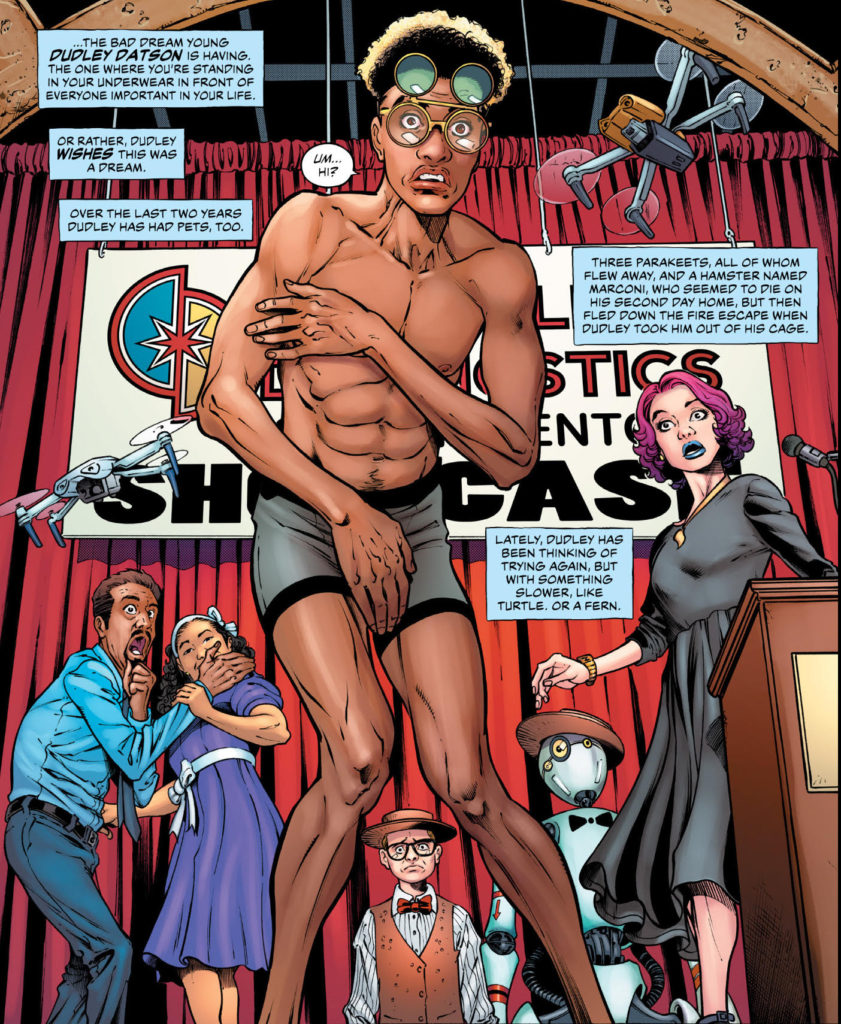
Great visual gag – but a lot of technology went into this. Art by Jamal Igle, Juan Castro, and Chris Sotomayor Image: Best Jackett Press
You’ve got the ideas, right? Let’s break down how this works…
The LCD fibers are all still there, right? They’re made of matter and can’t just go “clear,” allowing light to travel through them. For the fibers to produce the image we see on the page, they would have to have cameras pointed inside toward the person (as well as interior lights that can match the ambient light). With that combination of inward-pointing cameras and lights, you’d see what the person is wearing under their clothes. And of course, for the image to look accurate, the outward-facing cameras would have to work to accurately show what the inside (the naked body) would look like under the ambient conditions on stage. That’s a lot of processing power along with that engineering.
Don’t get me wrong — I loved the issue. It’s a lot of fun, and as I said, I’m hooked for the duration. I love the tech and that STEM and STEM Ed are front and center in the story. I’m not trying to take anything (okay, maybe suggest some caution in student-teacher touching) away from the issue at all.
At the same time, it’s useful to break down Dudley’s technology as a lesson of sorts on where we are and where we need to be if we’re going to see tech like this in our world. We need huge advances in miniaturization, computer processing, predictive AI tech, materials science, and more that we’d learn about as we go to make the technology that Dudley whipped up. Someday? Maybe. Soon? Not likely.
As for Dudley? I only hope that after his first adventure, he does what Peter Parker should have done from the very start – first, get patents for all the technology and materials he created from scratch. Second, lawyer up and firmly say “no” to the military when they ask for exclusive rights to everything. Instead, license the patents out to worthwhile, ethical manufacturers and then spend those millions/billions on social programs that would reduce and prevent crime in the first place.
Dudley Datson and the Forever Machine is available from Amazon’s Comixology Originals.


